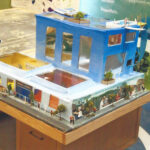Book Review: Arnd Schneider, ed. Alternative Art and Anthropology: Global Encounters, (London; New York: Bloomsbury Academic, 2017)
Alex Kershaw
This volume, edited by Arnd Schneider, promises to illuminate practices at the intersection of art and anthropology—practices taking place outside the purview of North America and Europe. It begins from the premise that, by and large, our sense of what constitutes the contemporary discourse is largely calibrated by efforts in the global North. Turning southward, the volume collects writing on specific projects by artists, curators, and anthropologists from around the globe, including Africa, Bhutan, Chile, China, Ecuador, Indonesia, Japan, and the Philippines (although several of these projects trace intercultural collaborations with the United States and Switzerland). The book’s nine essays and eight interviews seek to redress this imbalance by engaging these atypical perspectives in debates surrounding incompleteness or partial knowing, translation and difference, fieldwork, and alterity. Through thick descriptions of individual projects, the volume looks at how equality is enacted, critiqued, and counteracted through forms of collaborative practice. The discipline of art is often mobilized as exemplary of how difference can be productively harnessed as a form of what Schneider calls “incomplete translation.” While this might help keep uneven power dynamics in check or enable otherness to be embraced as a position of power, it also exposes the unequal forms of relation at work in collaborative practice. Thus, the book argues that the visual is not just ancillary to, but essential for the production of anthropological knowledge.
It is not only their geographic locations that make the practices featured in the book alternative, but the varying formats for how art and anthropology are brought together. In terms of scope, the essays cover critical reflections on artists engaged with anthropological theory and fieldwork practice, speculative theoretical texts on what should constitute the field of art anthropology, art exhibitions as the outcome of ethnographic fieldwork, anthropological studies of artistic practice, curation as a form of anthropological research, multi-sited intercultural mural projects, and the use of ethnographic method to bring artists, craftspeople and anthropologists together in collaboration. All this works to give form to what constitutes interstices between art and anthropology when it is not interpretations of non-Western objects or ethnographic filmmaking. It is refreshing that the authors are not overly preoccupied with now well-worn debates over art’s legitimacy in anthropological practice, nor do they position art simply as a medium for translating ethnographic knowledge. Neither do they see art as a corrective to anthropology’s more universal claims to knowledge through strategies such as parody, irony or antagonism. Instead, the practices described here constitute earnest attempts to figure out how these two disciplines can work concurrently at producing and problematizing knowledge.
The book’s editor, Arnd Schneider, is a social anthropologist, whose work will be familiar to most readers with an existing interest in the topic. Many of the disciplinary concerns teased out by the contributors of this book have their vestiges in his earlier works, such as Contemporary Art and Anthropology (Berg, 2006), Between Art and Anthropology (Berg, 2010), and Anthropology and Art Practice (Bloomsbury, 2013). Schneider has long been a proponent of the productive potential for interchanges between art and anthropology. Art practice, he argues, has the capacity to expose and ameliorate a variety of anthropological phobias—where art’s more sensual and performative modes of engagement are instructive for anthropology in the way it reveals the constructed nature of representation and works to re-order ontological frameworks for producing knowledge. In a different way, this text participates in the recent turn toward mixed ontological perspectives with several of the chapters being co-authored. Given Schneider’s previous scholarship on international migration, it is not surprising that the overwhelming majority of the book’s 17 contributors have footholds in more than one culture. The nature of their diasporic perspectives includes artists, anthropologists, curators, and art historians, working between Africa/the Philippines and the US, the Netherlands and Indonesia/Chile, Japan and China, as well as the UK and Malaysia. Thus, as interlocutors with footholds inside and outside cosmopolitan centers, the perspectives of the book’s authors are at once proximal and distant.
For the book’s first chapter, Schneider establishes the terrain and themes engaged by the subsequent essays. For the most part, each essay is followed by a short interview with the editor. Individually titled, the interviews function as meta-narratives throughout the book—as sutures that attempt to weave cohesion into the text by unpacking each specific encounter in terms of its implications for the discipline as a whole. The volume is illustrated with a total of 64 black and white photographs that document the creative processes and outcomes of each project. Schneider advocates for a way of conceptualizing alterity via what he calls “uneven hermeneutics,” which characterizes a form of translation that respects difference and resists absolute knowledge. The relationships that artists and anthropologist build with their subjects are encapsulated in this concept, “which refrains from any totalitarian or levelling form of interpretation and understanding, but has to be negotiated in a mutual, and yet uneven (but not unequal), process of collaboration.”[1] In a way that is reminiscent of Jean-François Lyotard’s notion of the differend, “uneven hermeneutics” is means of doing justice to the way experience is transformed into knowledge via incompleteness and partial knowing, where alterity is kept in play as a strategy for meeting half way between distinct worlds.
Several of the book’s contributions reflect on the exhibition format as a framework for instigating interdisciplinary cross-cultural encounters. For example, the intrinsic frictions of multi-authored projects are addressed by Almira Astudillo Gilles, who critically examines a collaborative project he directed involving artists from the Philippines and Filipino-American artists from Chicago. They produced works using a collection of 10,000 Philippine ethnographic objects held by The Field Museum of Natural History in Chicago as a central point of conversation. In what can be described as a form of reversed art anthropology, these objects served as catalysis for unpacking conflicting notions of contemporary Philippine transnational identity. Their collaborative work on two murals became a forum in which differences between individual and collective identity played out in ways that undermined the director’s vision for the project. In Tomoko Niwa and Tadashi Yanai essay, the model of the artist-ethnographer is extended and adapted for the curator-anthropologist who becomes less a custodian of finished works, but takes on a more active role in fieldwork and research. Similarly, Adeline Ooi writes about an exhibition she co-curated with Mella Jaarsma where they paired artists with researchers from the social sciences to make new works on subjects ranging from illegal gambling to batik-making. In their own way, each of these projects engage in what Jean Rouch called shared anthropology, where subjects are more complicit in how their culture is transformed when read in new contexts and where the artwork acknowledges a more expanded sense of authorship.
Elsewhere in the volume, several essays work together as counterpoints that blur our understanding of what constitutes the genre of art anthropology. Shinichi Nakazawa takes a conceptual route by outlining a model that speculates an alternative future for anthropology. Taking his cues from Levi Strauss and George Bataille, the author argues that if anthropology is to survive as a useful discipline it needs to harness the savage, mythical and transcendent modes of thought. In part, this essay’s quixotic tone serves as a pep talk for anthropologists to encourage them to think of art practice as a model for disciplinary inquiry. Performing a twist on more orthodox forms of art anthropology, Lilli Fang takes artistic practice in the context of developing city art districts in China since the 1990s as her object of study. While acknowledging that artists’ ambitions and the culture industry do not always have each other’s best interests at heart, Fang argues that these mutual agents of change have a symbiotic relationship. Her study paints a very positive role for artists in the postmodern city as integral to its political and economic vitality, where artists become cultural symbols of the city whose presence is closely linked with the development of the post-industrial society. Alternatively, the artist is rendered as being less complicit and more of a provocateur by X. Andrade, who charts a more critical role for public art projects. He introduces us to Full Dollar, an ongoing collaborative art project started in Guayaquil (Ecuador), that takes the form of a mock art institution that repurposes the visual language of craft and pop culture as form of institutional critique. Moving between academia and the art world, X. Andrade describes two projects where ethnographic method is used to collaborate with craftspeople and artists. These projects are concerned with the effects that images have on people and critique the way neo-liberal ideologies privatize and homogenize public space.
Overall, the book’s contributions look beyond binary relationships where anthropology either engages with art on merely formal terms as a mode of translation or where art practices uncritically assume forms of ethnographic authority. What the reader is privy to in the volumes’ examples are not the kinds of lopsided art practices Hal Foster had in mind in his critique of artist ethnographers back in 1996—but instead, we witness more subtly nuanced integrations of disciplinary method working together to produce knowledge that is both artistic and ethnographic. Furthermore, through rich descriptions of disparate projects, the book gives substance to what might actually constitute the nature of art anthropology beyond how the category is most typically understood as the anthropology of art or visual ethnography (most often associated with film practice). By assembling a critical forum for reflection, the reader is reminded that the art object is not necessarily the be-all and end-all of collaborative practice, but rather a moment to pause and analyze the knowledge produced, that may have no expression or even undermine its expression in material form.
Given that the authors were closely involved in the projects they wrote about, it is not surprising that there is a varying commitment to critical reflection. This wavered from struggling to look past the legacy of their intellectual endeavors (perhaps with future funding agencies in mind) to honest critiques that jeopardized the sanctity of collaborative relationships. Overall, a significant element that remains unresolved for the reader is whether the practices featured here actually constitute an alternative to cosmopolitan art/anthropology discourse or if the point is more that these “peripheral” practices have actually been participating in the debate all along, though unacknowledged as such. When it comes to situating these projects in broader contexts, the volume is perhaps too preoccupied with arguing for equivalence and relevance at the expense of thinking through how their alternative status might reorient debates between art and anthropology. To be fair, Schneider’s interviews with the book’s contributors begin to address the implications of these projects for the discipline more broadly, but their brevity often hinders attempts at getting at the heart of the issue. For readers inclined toward critiques of arts commodity status, the book will be refreshing for the emphasis it places on experimental process, reminding us that a project’s final material display might not always be the best metric for evaluating success. However, while we are witness to provocative experimentations between art and anthropology, many of the book’s examples would not likely qualify as vanguard practices, at least from the perspective of the visual arts. In this light, it might have been worth including more examples where disciplinary experimentation more fully registers itself as formal experimentation and a few less orthodox outcomes like painted mural projects and white cube gallery displays.
Certainly, the book fulfills its promise by introducing readers to the work of artists, curators, and scholars outside the gamut of mainstream western attention. It will be of interest to those seeking to broaden their perspectives on the variety of ways the movements between art and anthropology can be configured. It will be useful for curators, artist, and scholars engaged in writing up projects they are involved with as a model for different forms of critique that resist overindulging in cumbersome theorization. For the FIELD audience, this volume raises the question of whether these ethnographically inflected practices constitute a form of socially engaged art. At times, the reader is left wondering why mention of this genre is completely absent from the book. Perhaps, this should come as no surprise for the way “ethnography” is regularly invoked as a dirty word in contemporary art circles, often to leverage the genre of anthropology and its sketchy past against practices that use ethnographic method. Furthermore, this work is valuable for reminding readers that the social in socially engaged art is not as idolized as it might be in the west, not because it is unimportant, but because shared social function has long been a central tenant of artistic traditions elsewhere. More importantly, the book signals the potential for future lines of inquiry into what might be possible if art, anthropology, and socially engaged practice are brought into much closer orbit.
Alex Kershaw is a PhD Candidate in Art History, Theory and Criticism (Art Practice Concentration) at the University of California, San Diego and a member of FIELD‘s editorial collective.
Notes:
[1] Arnd Schneider, “Alternatives: World ontologies and dialogues between contemporary arts and anthropologies,” in Alternative Art and Anthropology: Global Encounters, ed. Arnd Schneider (London; New York: Bloomsbury, 2017), 21.











